Qatayef Asafiri (Atayef bil Ashta) are Middle Eastern pancakes filled with fragrant, rose and orange blossom-infused ashta cream. Chopped pistachios and syrup add a finishing touch to these hand-held sweets. They're perfect treats for the month of Ramadan, although I personally love them any time of year!
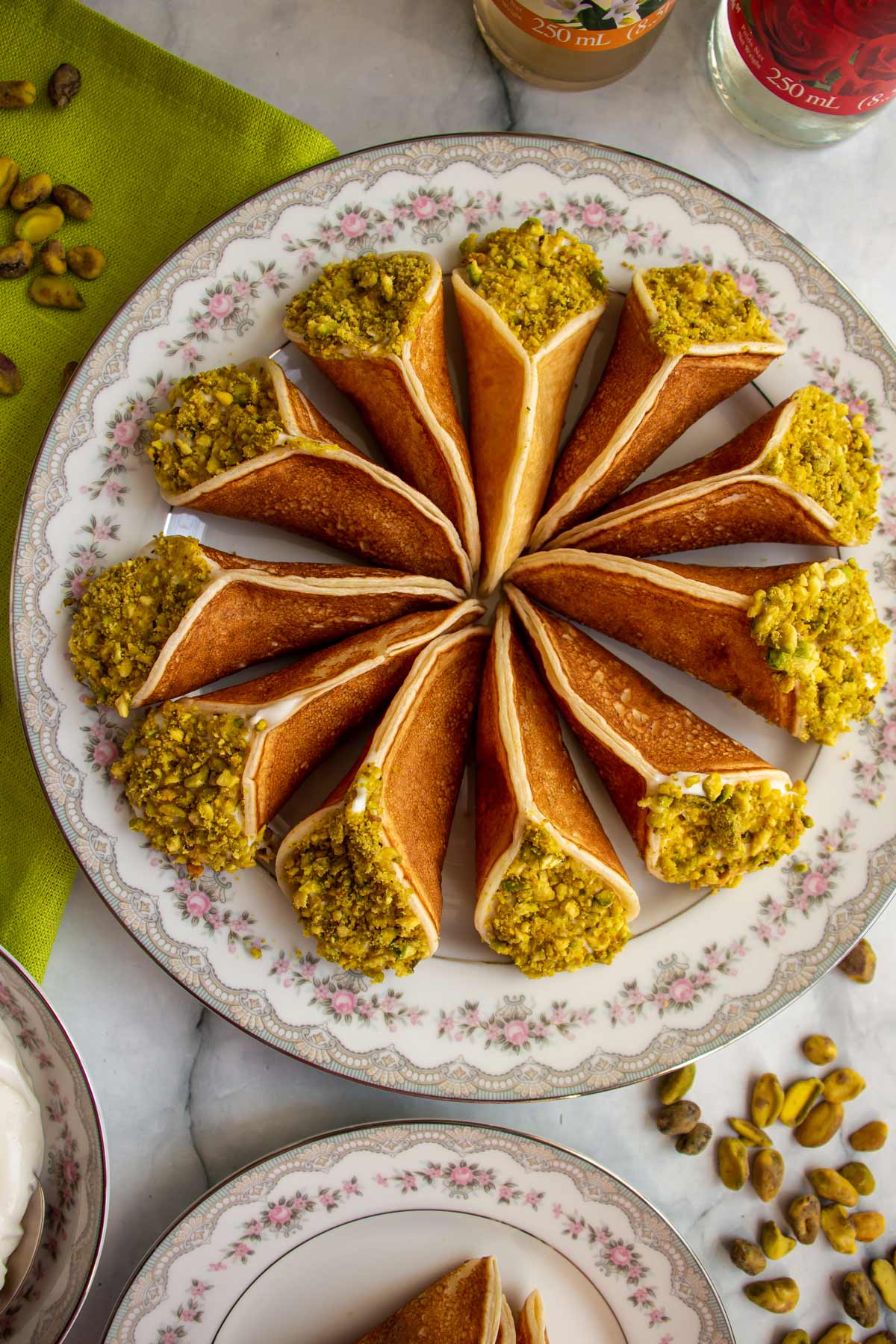
(This recipe was originally published in July 2011, but was updated with new photos and content in 2021).
Atayef, sometimes written as qatayef or katayef (قطايف), are small Arabian pancakes that are traditionally served during the holy month of Ramadan. They're popular in many Middle Eastern countries including Lebanon, Syria, Jordan, Iraq, Egypt, and Saudi Arabia.
Qatayef pancakes are really quite unique. They're lightly yeasted and only cooked on one side. Bubbles rise up in the pancakes and the surface dries out. Then they're removed from the heat and cooled before assembling. The uncooked side will stick together beautifully when pressed with light pressure.
They're usually filled with sweetened ricotta cheese, nuts mixed with cinnamon and sugar, or ashta (kashta, qashta, قشطة), a thickened clotted cream. Qatayef asafiri translates to "bird's pancakes" and refers to the small cone-shaped atayef pancakes filled with creamy ashta and served with a fragrant floral syrup.
The pancake is springy, fluffy, and tender. Meanwhile, the filling is thick, creamy and slightly floral, but not heavy at all. Chopped pistachios provide a lovely nutty crunch. This classic Arabic dessert is well-balanced in texture, flavor, and even color.
Ingredient notes
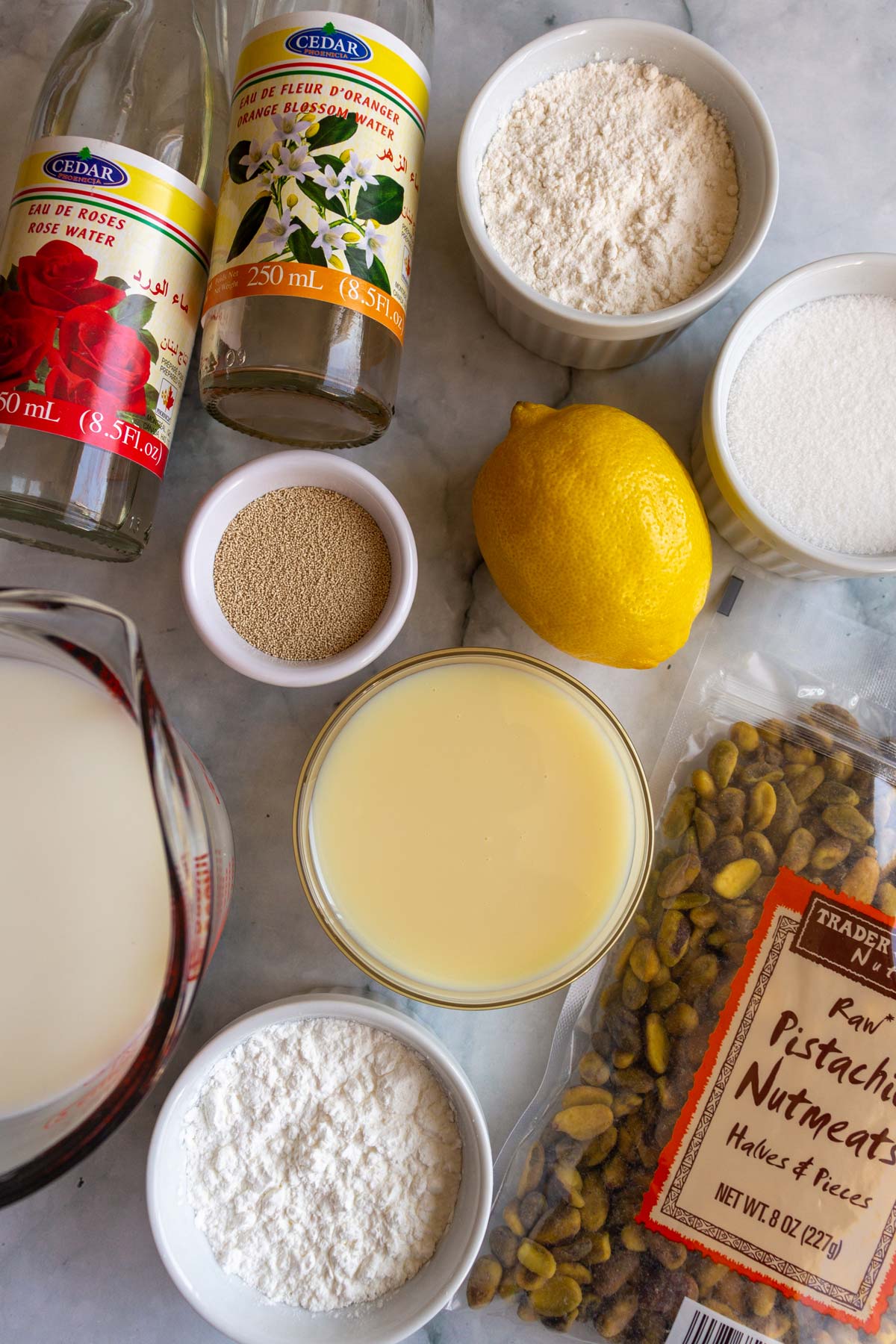
- Rose and Orange Blossom Waters: Both rose water and orange blossom water are common in various Middle Eastern recipes. Find both in the Middle Eastern aisles of supermarkets, Middle Eastern grocery stores, and online. If you only have one or the other, you can easily make this qatayef asafiri recipe with just rose or orange blossom water and omit the other (I recommend the orange blossom water in this scenario).
- Half-and-Half: If you can't get half-and-half for whatever reason, you may replace it with 1 ½ cups whole milk and ½ cup heavy cream OR 1 ⅓ cups skim or low-fat milk and ⅔ cup heavy cream to yield approximately the same fat content and volume needed for this recipe.
- Cornstarch: Many people use white bread as a thickener for ashta, while others stick with cornstarch only. Some also make ashta like clotted cream which is traditional but time consuming. We maintain that ashta tastes a bit heavier with the bread in it, so instead stick with cornstarch for easy thickening.
- Sweetened Condensed Milk: Ashta is not always sweetened, often relying on the drizzled syrup over the finished dessert to provide sweetness. Although it's not super traditional, sweetened condensed milk gives the ashta a bit of sweetness and richness that works perfectly for this recipe. You could also replace it with granulated sugar (about 1 to 2 tablespoons depending on your sweetness preference) or omit the sweetener entirely. Use leftover sweetened condensed milk to make Kheer with Condensed Milk, Tres Leches Cupcakes, Sweetened Condensed Milk Chocolate Buttercream Frosting, or Caramel Swirl Ice Cream.
- All-Purpose Flour & Semolina: I've made atayef before with only all-purpose flour rather than flour and semolina combined. It will work if you need to replace the semolina with an equal amount of flour, but the semolina is a traditional ingredient and helps with texture.
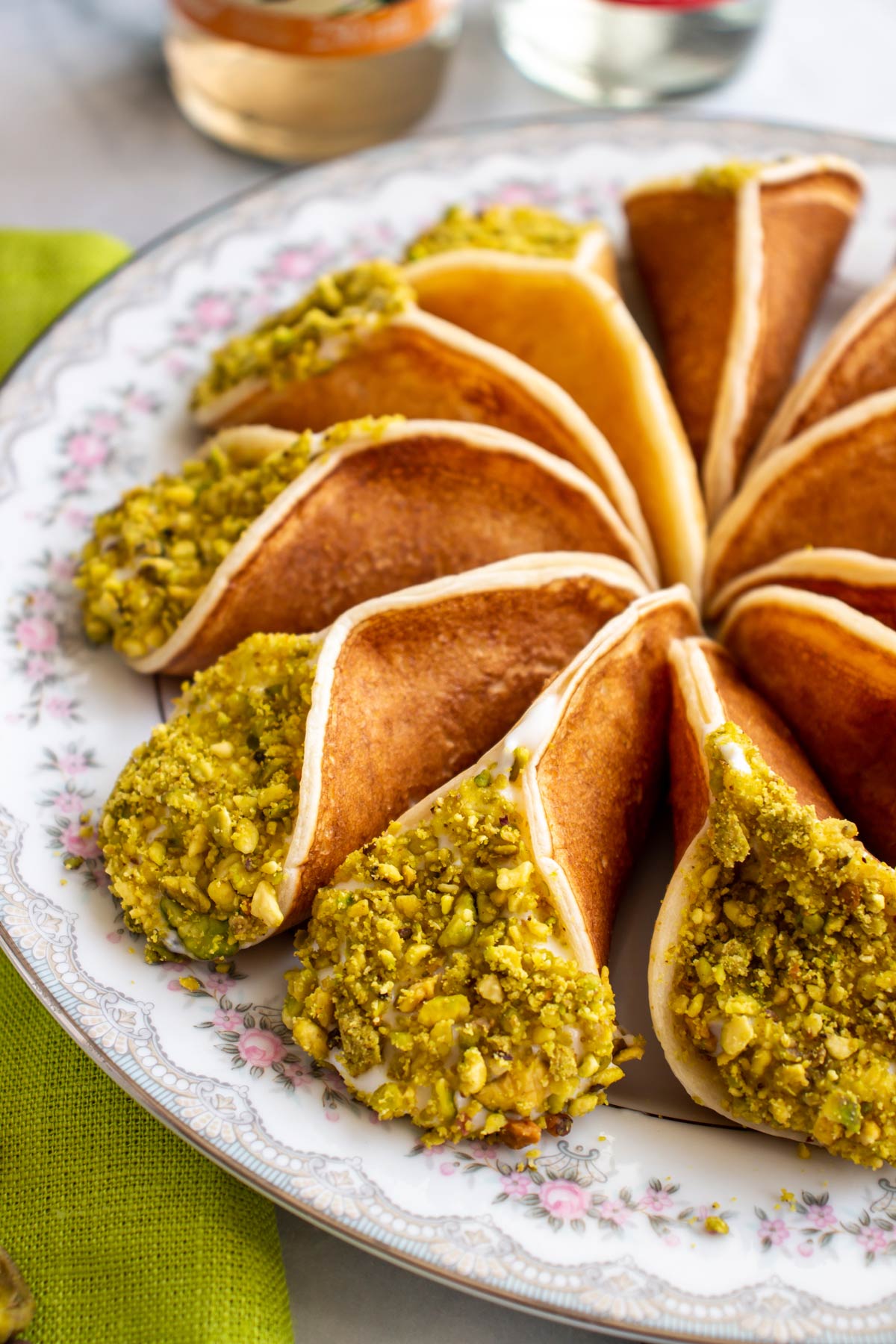
How to make it
Begin by making the ashta. Add half-and-half and sweetened condensed milk to a saucepan and heat. Meanwhile, combine cornstarch and water until smooth. Whisk the cornstarch slurry into the half-and-half. It will thicken almost immediately.
Remove from the heat and whisk in the rose water and orange blossom water. Pour into a container and top with plastic wrap, pressing the wrap to the surface. Cool completely and refrigerate until needed.
To make the syrup, heat sugar and water to a saucepan until boiling. Then add lemon juice and reduce the heat, cooking for 4 to 5 minutes longer. Remove from the heat and mix in the rose and orange blossom waters. Set aside to cool.
Next make the atayef pancakes. Mix together all the dry ingredients in a bowl and then whisk in the milk. Rest the mixture for about 10 minutes.
Heat a non-stick skillet or griddle. Add a scant ⅛ cup of the batter to the pan to form 3 ½-inch circles. Cook on one side only. Bubbles will rise to the surface and the top will start to dry out as it cooks.
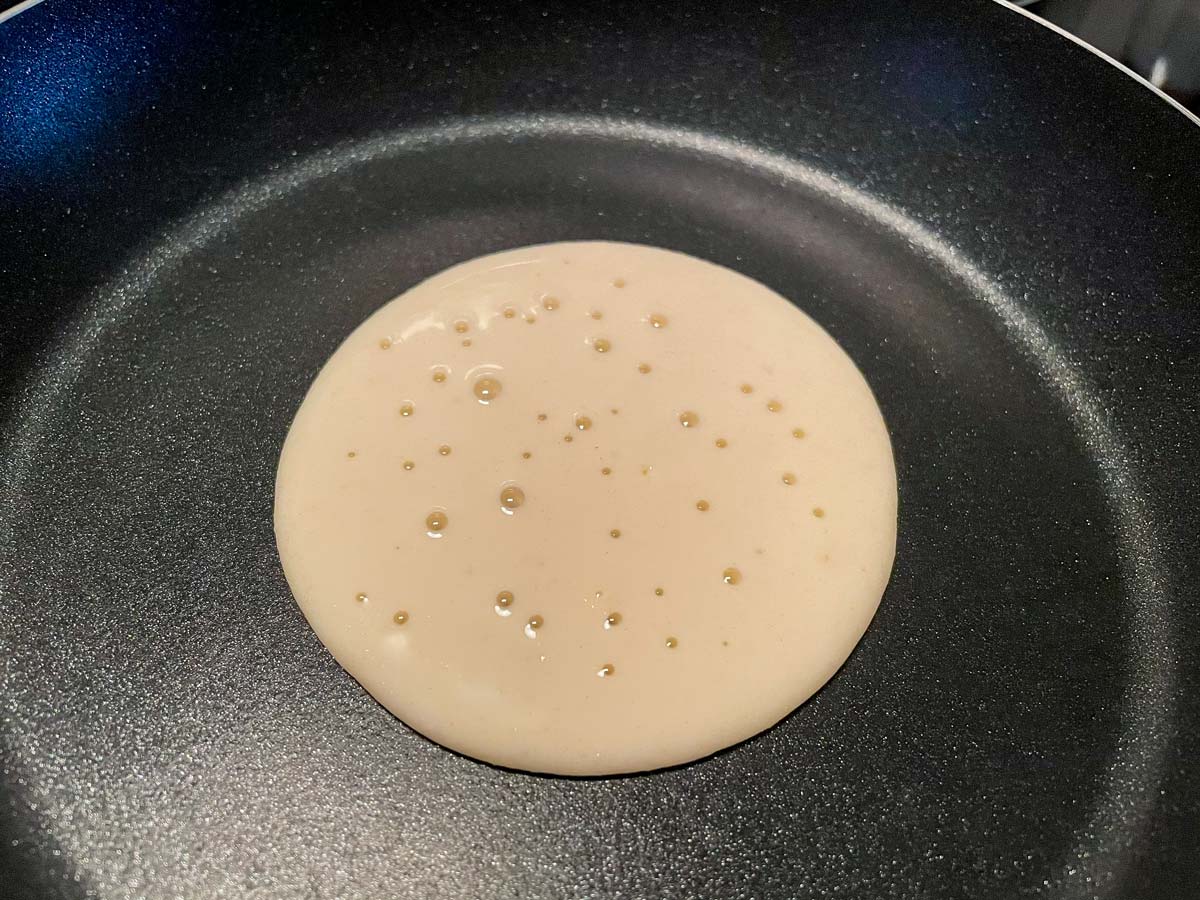
When the top has just turned dry and the bottom is golden, the pancakes are done. Do NOT flip them and do not overcook them. Remove cooked atayef with a spatula and cool before assembling.
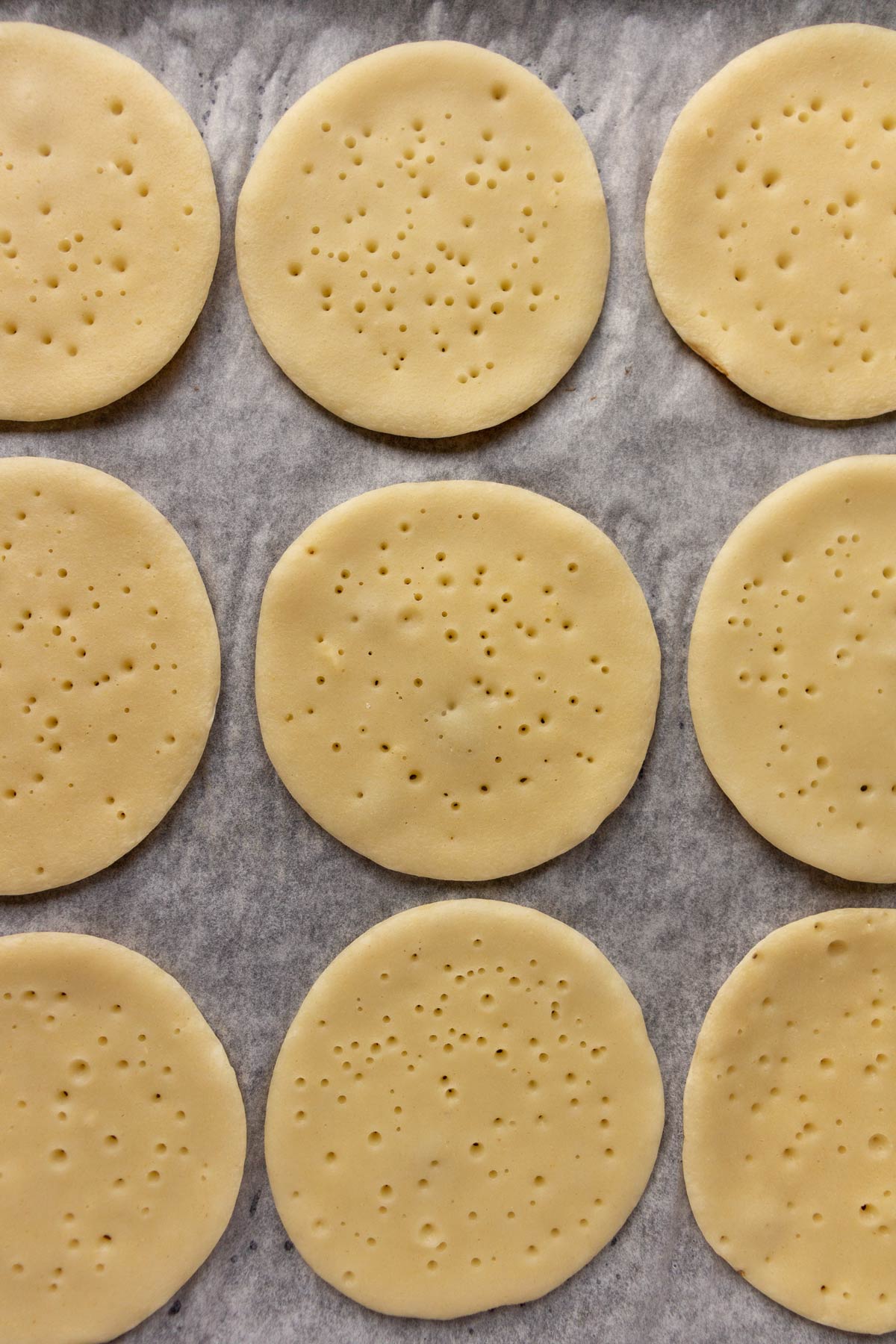
Finally it's time to assemble the qatayef asafiri! Take each pancake with the uncooked side facing up. Starting at one end press the edges to seal about two-thirds of the way with an opening at the opposite end.
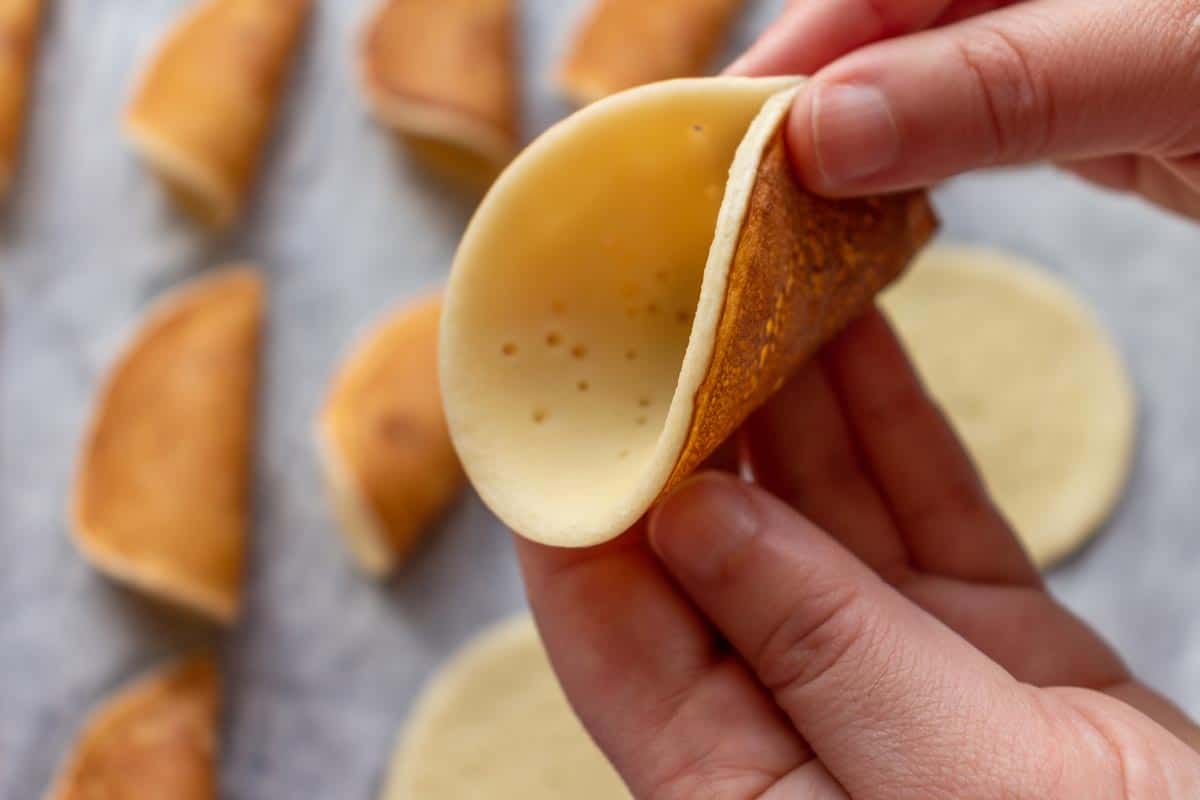
It should form a cone shape. Repeat with the remaining atayef pancakes. They will fall on their sides until the ashta filling weighs them down.
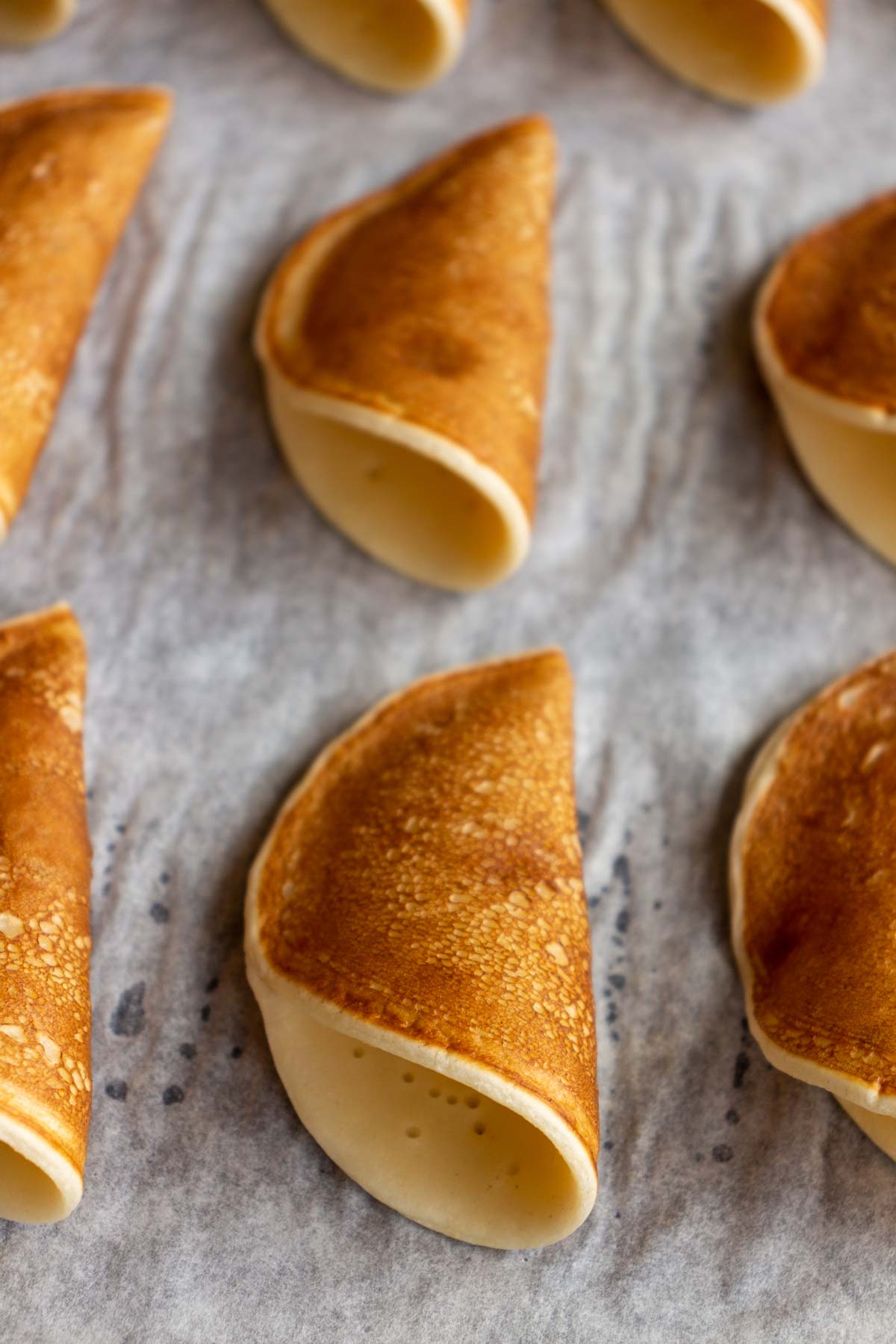
Vigorously whisk the ashta to loosen it up, and fill it into a pastry bag fitted with a medium round tip or into a disposable pastry bag cut at the end. Pipe the ashta into each of the atayef cones filling them fairly generously.
Dip the exposed ashta of each atayef into crushed pistachios to finish. Serve with the syrup for drizzling.
Please scroll to the bottom of the post for the full recipe (in a printable recipe card) including ingredient amounts and detailed instructions.
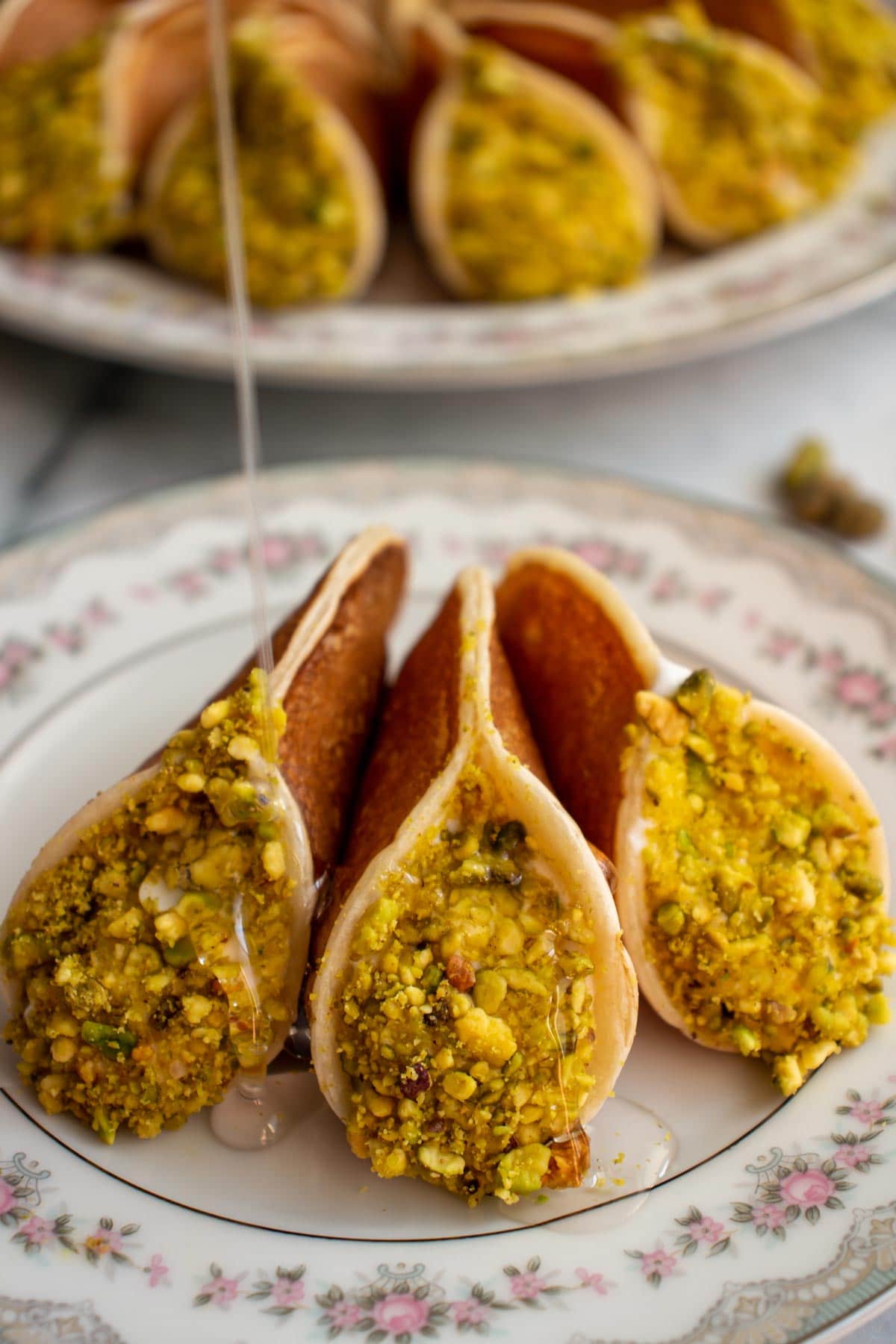
Expert tips
Qatayef asafiri is best the day you make it, but you can store leftovers in the refrigerator for about a day before the texture starts to change significantly. Only drizzle syrup over the top when serving, not in advance.
The skillet should be hot enough when you start cooking the atayef. I suggest starting around medium-high heat and then lowering the heat to medium or medium-low once you get into a groove. The pan will retain heat after the first batch or two and you don't want them browning too quickly.
Much like any pancakes the first ones may not look perfect but that's ok. Small bubbles should form on the surface shortly after adding batter to the pan. If you don't see small bubbles after a few seconds, the mixture may be too thick or your baking powder may not be fresh. In this case add water by the teaspoonful and keep going. If you still don't see bubbles, stir in another ½ teaspoon baking powder.
It's very important not to overcook the atayef. The moment the surface is dry remove it from the heat. If you overcook it, it won't stick together when you try to assemble.
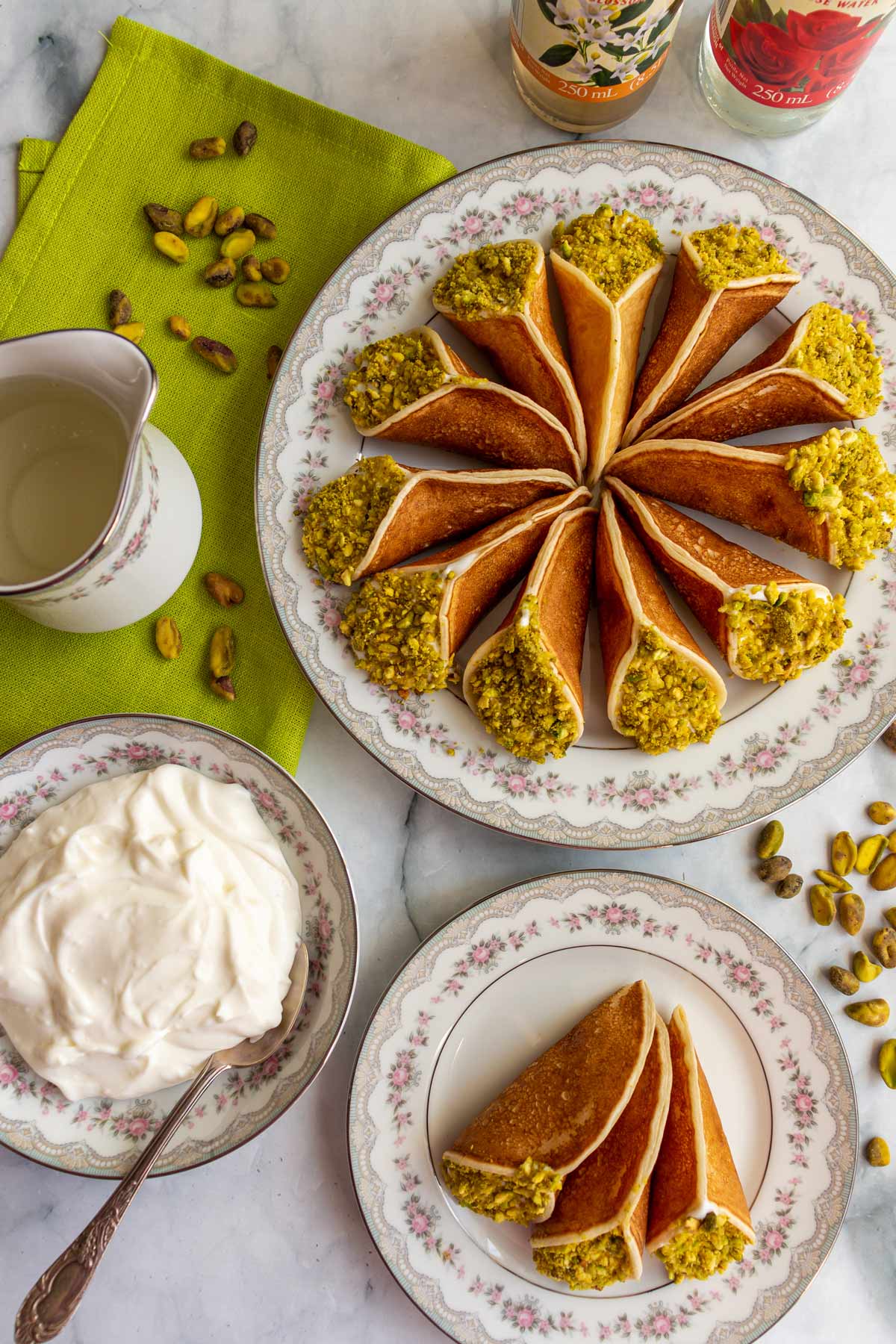
In addition to the boat-like shapes for these qatayef asafiri, you can also fill atayef with ricotta cheese or nuts mixed with cinnamon and sugar, sealed completely, and then baked or fried. These are then served piping hot, drizzled with cooled syrup.
The syrup is definitely worth making, although you can substitute honey if you desire. With that said I absolutely think the syrup gives this dessert an edge that would be otherwise lacking. It really brings out the faint floral flavor in the ashta as well.
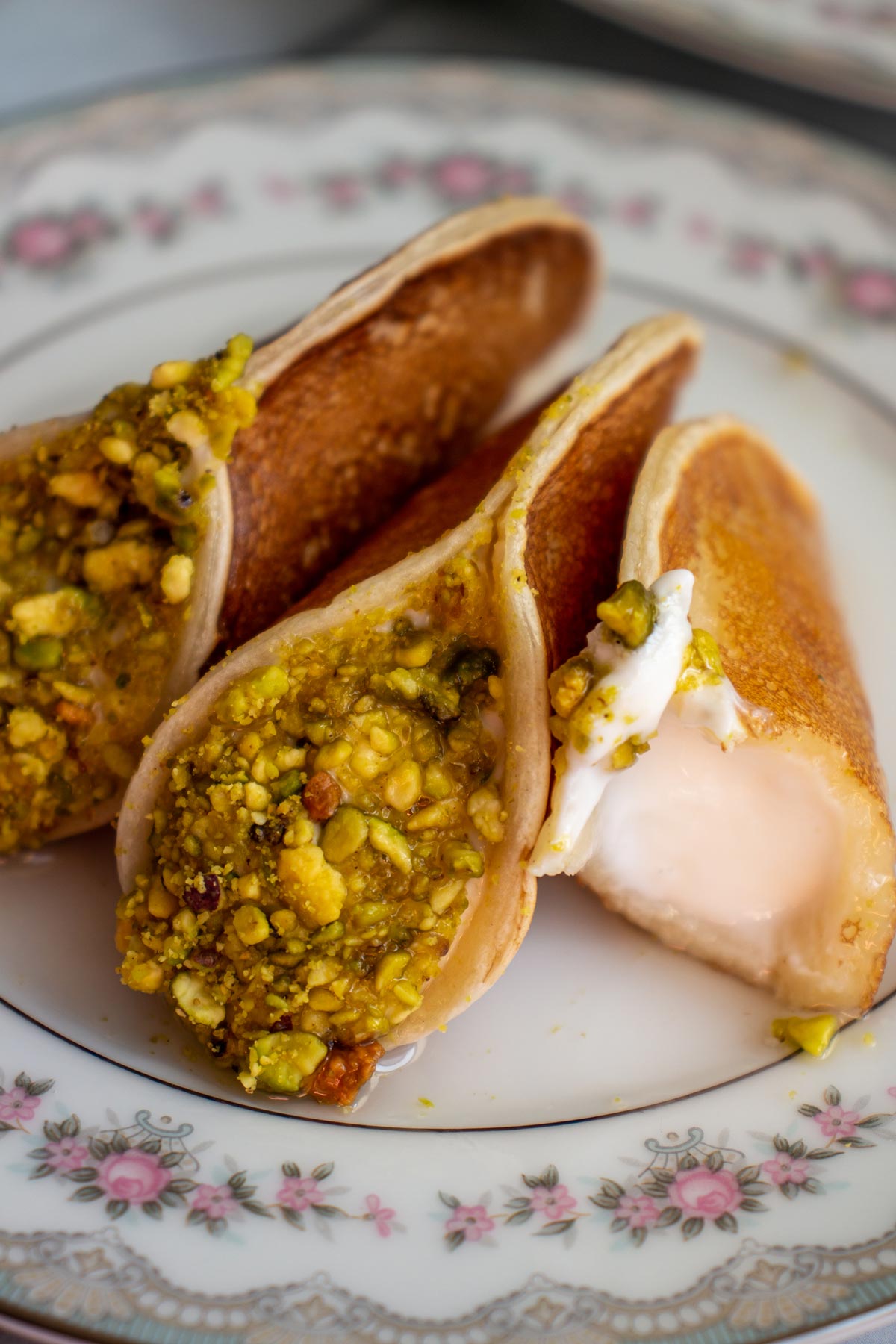
Other recipes you may like
- Kadaif or Kadayif (Cheese Kunafa Recipe)
- Sari Burma (Burma Baklava/Rolled Baklava)
- Paklava (Armenian Baklava)
- Armenian Gata
- Chorek (Armenian Sweet Bread)
- Matzoon Cookies (Armenian Yogurt Cookies)
- Russian Pirog with Apricot Preserves
Tried this recipe? Please leave a star ⭐️⭐️⭐️⭐️⭐️ rating in the recipe card below and/or a review in the comments section further down the page. You can also follow me on social media on Facebook, Instagram, and Pinterest!
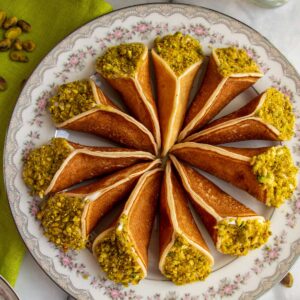
Qatayef Asafiri / Atayef bil Ashta (Middle Eastern Cream Filled Pancakes)
Ingredients
Ashta:
- 2 cups half-and-half
- 3 tablespoons sweetened condensed milk
- ⅓ cup plus 2 tablespoons cornstarch
- ½ cup water
- 1 tablespoon rose water
- 1 tablespoon orange blossom water
Syrup:
- 1 ¼ cups sugar
- ¾ cup water
- 1 ½ teaspoons lemon juice
- 1 teaspoon rose water
- 1 teaspoon orange blossom water
Atayef:
- 1 ¼ cups all-purpose flour
- ¼ cup fine semolina
- 1 teaspoon baking powder
- ½ teaspoon instant or rapid-rise yeast
- ½ teaspoon sugar
- 1 ¾ cups milk
Topping:
- ¼ cup shelled pistachios, ground/chopped (or more as needed)
Instructions
- To make the ashta: Add the half-and-half and condensed milk to a saucepan and heat over medium-high heat, stirring occasionally so it doesn’t burn. Meanwhile, whisk together the cornstarch and water until smooth.
- When the half-and-half mixture starts bubbling, whisk in the cornstarch slurry and keep whisking until very thick (it should be almost immediate). Remove from the heat and whisk in the rose water and orange blossom water.
- Pour the ashta into a bowl or lidded container and top with plastic wrap, pressing the wrap to the surface of the custard (to prevent a skin from forming). You should have about 2 ½ cups of ashta. Cool completely and refrigerate until needed.
- To make the syrup: Add the sugar and water to a saucepan and heat over medium-high heat, stirring occasionally. When the mixture starts boiling, add the lemon juice and slightly lower the heat to maintain a gentle boil. Cook for 4 to 5 minutes longer to thicken it slightly.
- Remove from the heat and mix in the rose and orange blossom waters. Set aside to cool. This syrup will keep well in an air-tight container in the refrigerator until needed.
- To make the atayef pancakes: Combine the dry ingredients in a bowl and then whisk in the milk. Set the mixture aside for about 10 minutes.
- Meanwhile, heat a non-stick skillet or griddle over medium to medium-high heat. Add a scant ⅛ cup (about 1 ½ tablespoons) of the batter (which should be slightly thicker than a crepe batter) to the pan to form 3 ½-inch circles. It should spread out on its own. Cook the atayef on one side only. Bubbles will rise to the surface and the top will start to dry out as it cooks (if bubbles do not start to rise almost immediately, your pan isn’t hot enough or the batter is too thick). When the top is dry and the bottom is golden, the pancakes are done. Do NOT flip them. Just set them aside until needed. Continue cooking the pancakes and allow them to cool for a few minutes before assembling.
- To assemble: Take each pancake with the uncooked side facing up. Starting at one end press the edges to seal about ⅔ of the way with an opening at the opposite end. It should form a cone shape.
- Remove the ashta from the refrigerator and whisk vigorously until smooth (it will be very thick). Fill the ashta into a pastry bag fitted with a medium round tip or into a disposable pastry bag cut at the end. Pipe the ashta into each of the atayef “boats” filling fairly generously.
- Immediately dip the exposed ashta of each atayef into crushed pistachios to finish. Serve with the syrup for drizzling. Alternatively, serve with honey.
- These are best the day they are made, but leftovers can be stored in the refrigerator for about a day before the texture starts to change significantly.
Notes
- The skillet should be hot enough when you start cooking the atayef. I suggest starting around medium-high heat and then lowering the heat to medium or medium-low once you get into a groove. The pan will retain heat after the first batch or two and you don't want them browning too quickly.
- Much like any pancakes the first ones may not look perfect but that's ok. Small bubbles should form on the surface shortly after adding batter to the pan. If you don't see small bubbles after a few seconds, the mixture may be too thick or your baking powder may not be fresh. In this case add water by the teaspoonful and keep going. If you still don't see bubbles, stir in another ½ teaspoon baking powder.
- It's very important not to overcook the atayef. The moment the surface is dry remove it from the heat. If you overcook it, it won't stick together when you try to assemble.
- I've made atayef before with only all-purpose flour rather than flour and semolina combined. It will work if you need to replace the semolina with an equal amount of flour, but the semolina is a traditional ingredient and helps with texture.
- Ashta is not always sweetened, often relying on the drizzled syrup over the finished dessert to provide sweetness. Although it's not super traditional, sweetened condensed milk gives the ashta a bit of sweetness and richness that works perfectly for this recipe. You could also replace it with granulated sugar (about 1 to 2 tablespoons depending on your sweetness preference) or omit the sweetener entirely.
Nutrition
*All nutritional information is based on third-party calculations and should be considered estimates. Actual nutritional content will vary with brands used, measuring methods, portion sizes and more.*

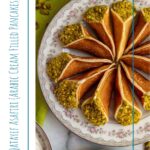
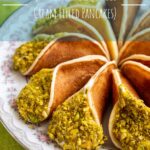

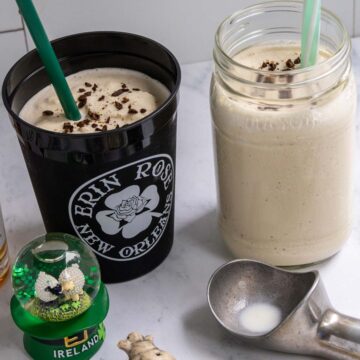



Micheline says
This turned out amazing!!
Mary Kabakian says
These are so soft, creamy, melt in your mouth and absolutely delicious!!!